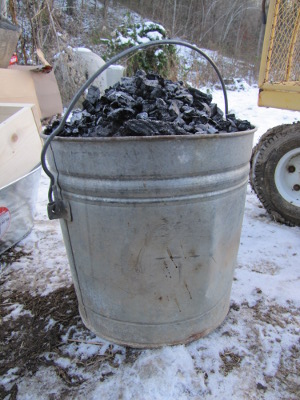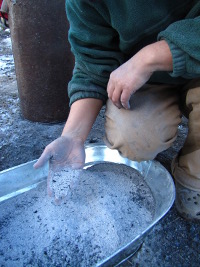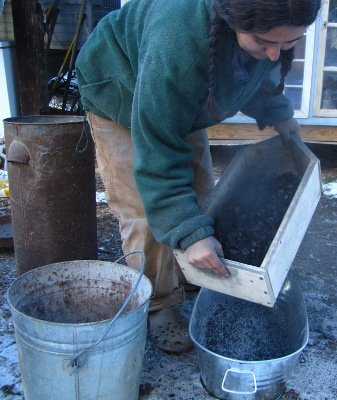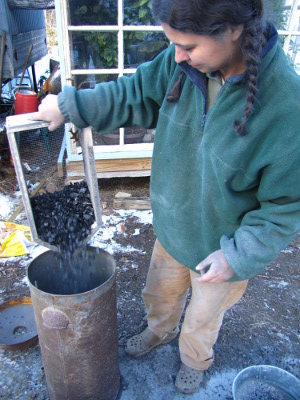
Wood stove biochar experiment
 Once
I started damping our Jotul
F 602 wood stove
down at night, I realized that the stove makes copious amounts of first
class charcoal. Thirteen days of fires filled up our bucket
beyond the brim --- time to figure out how to filter the charcoal from
the ash.
Once
I started damping our Jotul
F 602 wood stove
down at night, I realized that the stove makes copious amounts of first
class charcoal. Thirteen days of fires filled up our bucket
beyond the brim --- time to figure out how to filter the charcoal from
the ash.

Both wood ashes and
charcoal are good for the garden, but they have different uses.
Ash is high in potassium, and also contains quite a bit of phosphorus,
magnesium, and various trace minerals. More important, though,
wood ashes are a quarter to a half calcium carbonate (aka "lime"), so
you have to be aware that you will raise the pH of your soil by
applying the ashes. Since our soil already has a pH around 6 and
our potassium levels are naturally very high, I don't want to apply too
much ash or I'll raise the pH above the optimal 6.5 recommended for a
vegetable garden and possibly bring the potassium up to toxic levels.

The charcoal is what I'm
really excited about. We've been sold on the benefits of
biochar to soil,
but haven't
been ready to put in the time to build a biochar production
chamber. Sure is nice of the airtight wood stove to do that job
for us while also producing plenty of heat to keep my toes warm.

I built a sifting box to
separate the charcoal from the ashes, a process that went pretty
smoothly but needs a bit of tweaking. First of all, even though
the coals had been sitting in the ash bucket for nearly twelve hours,
some were still burning, and I scorched the wood  on
the inside of my sifter. Mark suggested adding flashing to the
inside, which is a great idea. The job was also pretty messy, with ash flying everywhere --- maybe I need to add a lid to the top of the sifter?
on
the inside of my sifter. Mark suggested adding flashing to the
inside, which is a great idea. The job was also pretty messy, with ash flying everywhere --- maybe I need to add a lid to the top of the sifter?
Despite needing some
optimizing, the sifting operation went quickly once I realized I should
only dump in about four inches of stove debris at a time and jiggle the
sifter a lot to get the ashes to fall through the holes. The
really difficult bit will be figuring out how to crush the biochar into
powder. We could use the chunks as they are, but my understanding
is that we get more surface area and more microbial action if we crush
the biochar into much smaller pieces. While we put our thinking
caps on, I'll be storing our charcoal in a metal container so that it
can't burn through the bottom and start a fire.
Want more in-depth information? Browse through our books.
Or explore more posts by date or by subject.
About us: Anna Hess and Mark Hamilton spent over a decade living self-sufficiently in the mountains of Virginia before moving north to start over from scratch in the foothills of Ohio. They've experimented with permaculture, no-till gardening, trailersteading, home-based microbusinesses and much more, writing about their adventures in both blogs and books.
Want to be notified when new comments are posted on this page? Click on the RSS button after you add a comment to subscribe to the comment feed, or simply check the box beside "email replies to me" while writing your comment.

You could use wood ash to make lye for making soap or curing olives. Be careful though, concnetrated lye is caustic.
Roland --- good idea! We don't use much soap, though, and can't grow olives. We'd still have a lot left over. Any other ideas?
Vester --- Addition to our compost is the goal once we get the biochar ground down (although I'll probably actually add it to the bedding in the chicken coop so that it'll get the high nitrogen manure, which is supposed to jumpstart microbial colonization.) I tried mashing it with a four by four a bit like you're talking about doing with a bat, but that didn't work very well. Perhaps it would have done better if I'd poured out most of the charcoal and just been mashing a few inches worth --- this way, the charcoal mostly drifts out of the way of the pestle rather than getting ground down.
J --- Thanks! As always.
By heating the calcium carbonate you can create calciumoxide (quicklime) which can be used to make lime mortar or even limecrete, which are eco-friendly building materials.
There's at least ten more uses.
Anna,
How to you make your sifting box. I was telling my brother about your homestead and he was interested. He's currently just roto-tilling the ash and charcoal into the garden all together.
There isn't much too it as currently constructed. I used one 8 foot 1 by 6, cut it down into five pieces, and screwed the box together. You could just make a four-sided box, but the pointed side is useful for pouring out coals. Then I stapled hardware cloth (a wire mesh with small holes) on the bottom. In retrospect, I might have added a coating of metal flashing to the inside to keep the wood from charring when I sift hot coals (but it's also pretty easy to wait and just sift the coals once they cool.)
There's room for improvement (especially needs a lid!), so I'd be very curious to see what your brother comes up with. Also, we've mulled over several ideas for grinding the charcoal, but haven't come to any conclusions yet.
When sifting ash it is light, becomes airborne and is readily inhaled. It contains silica as well as lye and is very dangerous to breathe. One should wear a respirator, a mask does not filter out micro-sized silica particles that lodge deep in the lungs. I am a potter, I make glaze from wood ash, if you can wash the ash out once it is wet it is no longer breathable and in a much safer form. But keep your hands out of what will then be the caustic water. I found your post because I am looking for other uses for the wood ash and in particular want to make mortar or concrete and had a sense there would be an application here knowing something of the chemistry.